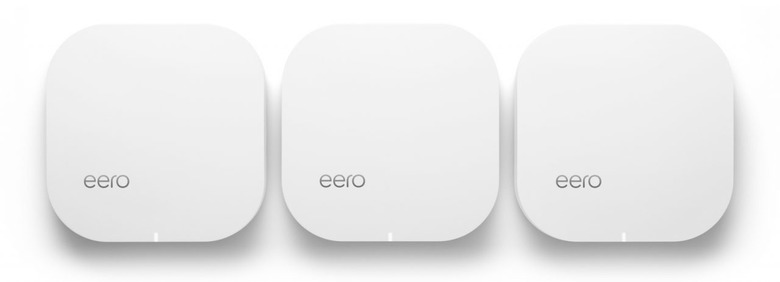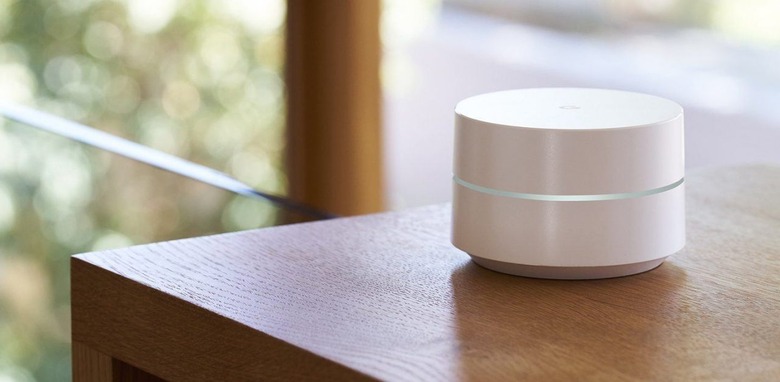What Is Mesh Networking And Can It Fix My WiFi?
We may receive a commission on purchases made from links.
YouTube videos stutter, network backups take an age, and every Spotify playlist sounds like trip-hop from all the hiccups and pauses: face it, your WiFi network needs an intervention. Once upon a time that meant switching over to the newest, fastest router, but there's a new technology in town. Mesh networking is the wireless fix of the moment, and there's a good reason for that.
Why is mesh networking so big right now?
Blame your appetite for fast, pervasive internet access. You want to get online wherever you are, whenever you want, and most homes aren't designed with that in mind. Whether it's the position your cable modem is located in, or the physical construction of the building interfering with your existing WiFi router, people aren't willing to live with bottlenecks, especially when they're paying big money for many-megabit, or even gigabit, internet connections.
Meanwhile, the rise of cloud-based services – whether email, online word processing and other office-style suites, and streaming media – has put more emphasis on the way in which we access them. It doesn't matter how capable Google Docs is if you can't access it consistently. Spotify might have tens of millions of songs, but a vast online jukebox isn't much use if your poor connection leaves tracks stuttering
Just what is a mesh network?
The quickest path between two points is a straight line. If you have multiple points, you end up with a lot of straight lines: that's several different routes from a point on one side to another point on the opposite side.
In mesh networking, each point is a router unit. They're all connected to each other – usually wirelessly, though wired is generally better for performance if you can string a cable – and they pass data between each other. If your phone is paired with mesh router A, and it's trying to communicate with the cable modem linked to mesh router C, the distance between the two might be too far for their wireless link. However, mesh router B in-between can act as an intermediary.
Each of those intermediary jumps is a mesh networking "hop" and there are advantages to minimizing their number. Every hop introduces some degree of delay, so finding the most direct route is best for overall performance. However, with enough mesh routers – or "nodes" – there's redundancy: if one is offline for whatever reason, the signal can work its way around it using alternate routes through different nodes.
Why would I need a mesh network?
In an ideal networking world, your internet connection would arrive at a central point in your home where a single wireless router would live. That could equally and evenly blanket the whole building, or apartment, or condo, with WiFi; no matter where you went, you'd be able to connect to it. Problem is, that's rarely the case.
Perhaps your internet cabling arrives in the cupboard under the stairs, or all the way over on one side of the house. Maybe it's on the ground floor, but you have two or three more levels above, all with people and their various digital devices that want to get online. Traditionally, the fix would be to pay to have the cabling extended, get a more powerful wireless router, or resign yourself to moving closer if you want more bars of signal.
Routers are designed to create a bubble of wireless coverage. More recent WiFi standards have added support for beamforming – essentially targeting the radio signal in the specific direction of a client device – but it's not infallible and it can't work miracles. That's where mesh networks come in.
In effect, each node in the mesh system acts to expand the bubble of your coverage, but a client device sees each as part of the same single network. So, if you have a tenuous connection in your attic, you could put a mesh router there, and it would bridge your devices with its counterpart router down where your cable modem is.

Where it gets clever is when you have three or more routers involved. Most mesh networking systems – like eero, Almond, and soon-to-be-released Google Wifi – are sold in packs of three for convenience's sake, but theoretically you could keep adding units until you've blanketed whatever space you're dealing with. Your device will automatically connect wirelessly to whichever the nearest router – or node – on the network is, with no involvement on your part. Meanwhile, the connection hops between unit to unit until it reaches the one hooked up to your modem, like water finding the easiest way down through a series of pipes.
What about WiFi range extenders?
"Hang on," you might be saying about now, "what about wireless network extenders? Don't they do the same thing, and for a lot less money?" Certainly the technology for taking an existing network – including the WiFi coverage the wireless router your cable company might have provided – and expanding it to a greater area in your home exists, without going for a mesh system
WiFi extenders, like this well-reviewed TP-Link AC1750 RE450 at around $90, promise to work with your existing router rather than demand a whole new set of hardware. They're straightforward to set-up, too, usually simply plugging into a spare outlet. The best can mimic the network name and password of your existing WiFi, as well as create an all-new network.
The big difference, however, is the semantics between "extension" and "expansion". Even if your WiFi range extender is called the same thing as your regular WiFi, and uses the same credentials, it's really a completely independent network. Moreover, there's no overarching management done between the two.
It means that, while in theory you'd only connect to the range extender's network when your link to the regular network is weak, there's no guarantee that will happen. Meanwhile, when you move back into range of the regular network, it's also not guaranteed that you'll disconnect from the extender. If you were relying on that extender to cover a network dead-zone in the garage, for instance, your phone might end up clinging to that connection even when you're back in the house.
Throw in the fact that network speed through the extender is usually far reduced compared to speed through your regular wireless router, and the lag involved in disconnecting from one and then connecting to the next, and all of a sudden the tech can seem more hassle than it's worth. It's not to say there's no use for them at all – if you can run an ethernet connection to where the extender is, that makes a huge difference, for instance – but many of the headaches are addressed with mesh routers.
So mesh is best?
Not always. For a start there's usually some speed overhead involved: your signal is jumping from node to node after all. A single, modern router supporting the latest wireless standards will almost certainly deliver faster speeds, assuming you're close enough to connect to it.

Meanwhile, though wireless may be convenient, it's still not as fast or as stable as a wired connection. If it's practical to run an ethernet cable from your main router to a point in the house where you struggle with poor WiFi speeds or patchy signal, you'll get better results than stringing a series of mesh nodes through the house instead.
Wrap-Up
Mesh networking isn't cheap, but if you're struggling with patchy WiFi, YouTube videos that refuse to load, or dreary data rates when trying to run a backup on your laptop, the outlay might be worth it. Still, it's worth checking if it's practical to move your existing wireless router to a more central position first. After all, a long ethernet cable is a lot cheaper than spending several hundred dollars on a mesh networking kit.
SlashGear uses Amazon affiliate links, and if you buy something we may get a small share of the sale
